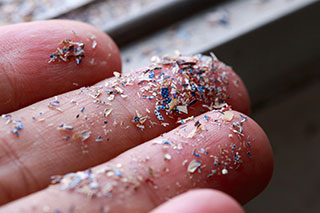
The Center for Native American Environmental Health Equity Research has begun its 2023-2024 pilot projects. The one-year awards support diverse early-career investigators who aim to address disproportionate exposures to toxic substances found in New Mexico’s Indigenous communities. Through this initiative, the center aims to develop strategies to reduce health disparities in Native American communities.
Protecting the Immune System
Christian Cabanlong, Ph.D., a postdoctoral fellow at the University of New Mexico (UNM), is linking the pollutant trichloroethylene (TCE) to autoimmune disorders. In previous research, Cabanlong detected biomarkers, or biological signs, of autoimmunity associated with metals exposure and with living close to metals waste sites. With this new funding, he hopes to reveal the mechanisms by which TCE exposure affects the immune system.
Science Communication
Anjali Mulchandani, Ph.D., and assistant professor at UNM, and Mallery Quetawki, UNM’s artist-in-residence, are collaborating on a pilot project to develop science communication programs to connect researchers, students, and Native American community members. They hope to establish a cohort of 10 trios of senior researchers, undergraduate students, and community members, with the goals of improving how researchers communicate science and help the partner communities gain a better understanding of the environmental health sciences.
Microplastics Exposure

Several researchers at the center study how microplastic contamination, from unregulated waste disposal and burning of waste, affects health.
Jorge Gonzalez-Estrella, Ph.D., an assistant professor at Oklahoma State University, will study how ultraviolet radiation affects the interactions between microplastics and organic compounds found in agricultural chemicals. Gonzalez-Estrella aims to reveal the effects of radiation on how well and how much of an organic compound can stick to microplastic pieces. This study will be critical for understanding the effects of microplastics on the toxicity of other contaminants of concern found in the environment.
Eliane El Hayek, Ph.D., an early-career researcher at UNM, is partnering with faculty and students at Little Big Horn College in Montana to address the Crow Nation’s concerns about how open burning and solid-waste dumping are impacting native plants, including plants consumed or used by the community for medicinal or traditional practices. El Hayek’s project will provide data on the type, abundance, and characteristics of plastic particles in soils, as well as how microbial communities may influence their accumulation in soil and uptake by plants.
Julie In, Ph.D., an assistant professor at UNM, will study the effects of microplastics on intestinal hormones. Previous research suggests that exposure to microplastics can disrupt the cells that line the human intestine and increase susceptibility to intestinal disorders. Through this project, In hopes to reveal the relationship between microplastics and gut health.
Xiang Xue, Ph.D., an early-career investigator at UNM, was granted funding to research the role of microplastic exposure in colon cancer. Colorectal cancer prevalence has been consistently increasing in men under 50 since 1994, and additional research shows that microplastics may induce oxidative stress in human colon cells. With this new funding, Xue hopes to further understand the role of microplastics in colon tumor progression.


